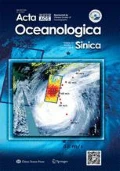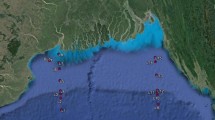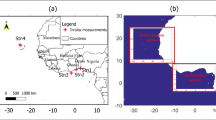Abstract
Wave climate analysis and other applications for the Pacific Ocean require a reliable wave hindcast. Five source and sink term packages in the Wavewatch III model (v3.14 and v4.18) are compared and assessed in this study through comprehensive observations, including altimeter significant wave height, advanced synthetic aperture radar swell, and buoy wave parameters and spectrum. In addition to the evaluation of typically used integral parameters, the spectra partitioning method contributes to the detailed wave system and wave maturity validation. The modified performance evaluation method (PS) effectively reduces attribute numbers and facilitates the overall assessment. To avoid possible misleading results in the root mean square error-based validations, another indicator called HH (indicating the two authors) is also calculated to guarantee the consistency of the results. The widely used Tolman and Chalikov (TC) package is still generally efficient in determining the integral properties of wave spectra but is physically deficient in explaining the dissipation processes. The ST4 package performs well in overall wave parameters and significantly improves the accuracy of wave systems in the open ocean. Meanwhile, the newly published ST6 package is slightly better in determining swell energy variations. The two packages (ACC350 and BJA) obtained from Wavewatch III v3.14 exhibit large scatters at different sea states. The three most ideal packages are further examined in terms of reproducing waveinduced momentum flux from the perspective of transport. Stokes transport analysis indicates that ST4 is the closest to the NDBC-buoy-spectrum-based transport values, and TC and ST6 tend to overestimate and underestimate the transport magnitude, respectively, in swell mixed areas. This difference must be considered, particularly in air–wave–current coupling research and upper ocean analysis. The assessment results provide guidance for the selection of ST4 for use in a background Pacific Ocean hindcast for high wave climate research and China Sea swell type analysis.
Similar content being viewed by others
References
Abdalla S, Bidlot J R. 2002. Wind gustiness and air density effects and other key changes to wave model in CY25R1. Rep, Research Department, ECMWF, Reading, UK
Ardhuin F, Chapron B, Collard F. 2009. Observation of swell dissipation across oceans. Geophysical Research Letters, 36(6): doi: 10.1029/2008GL037030
Ardhuin F, Jenkins A D. 2006. On the interaction of surface waves and upper ocean turbulence. Journal of Physical Oceanography, 36(3): 551–557
Ardhuin F, Rogers E, Babanin A V, et al. 2010. Semiempirical dissipation source functions for ocean waves. Part I: Definition, calibration, and validation. Journal of Physical Oceanography, 40(9): 1917–1941
Babanin A. 2011. Breaking and Dissipation of Ocean Surface Waves. Cambridge: Cambridge University Press, 480
Babanin A V. 2012. Swell attenuation due to wave-induced turbulence. Proceedings of the 31st International Conference on Ocean, Offshore and Artic Engineering (OMAE2012), 439–443
Babanin A V, Haus B K. 2009. On the existence of water turbulence induced by nonbreaking surface waves. Journal of Physical Oceanography, 39(10): 2675–2679
Babanin A V, Tsagareli K N, Young I R, et al. 2009. Numerical investigation of spectral evolution of wind waves. Part II: Dissipation term and evolution tests. Journal of Physical Oceanography, 40(4): 667–683
Bi Fan. 2013. On the wave-induced effect to circulation transport and the characteristics of swell propagation and dissipation (in Chinese)[dissertation]. Qingdao: Ocean University of China, 119
Bi Fan, Wu Kejian. 2014. Wave effect on the ocean circulations through mass transport and wave-induced pumping. Journal of Ocean University of China, 13(2): 175–182
Bi Fan, Wu Kejian, Zhang Yuming. 2012. The effect of Stokes drift on Ekman transport in the open sea. Acta Oceanologica Sinica, 31(6): 12–18
Bidlot J R, Abdalla S, Janssen P. 2005. A revised formulation for ocean wave dissipation in CY25R1. in Tech Rep Memorandum R60. 9/JB/0516. Research Department, ECMWF, Reading, UK
Chalikov D. 1995. The parameterization of the wave boundary layer. Journal of Physical Oceanography, 25(6): 1333–1349
Chalikov D V, Belevich M Y. 1993. One-dimensional theory of the wave boundary layer. Boundary-Layer Meteorology, 63(1–2): 65–96
Dodet G, Bertin X, Taborda R. 2010. Wave climate variability in the North-East Atlantic Ocean over the last six decades. Ocean Modelling, 31(3–4): 120–131
Fan Y, Lin S-J, Held I M, et al. 2012. Global ocean surface wave simulation using a coupled atmosphere–wave model. Journal of Climate, 25(18): 6233–6252
Grachev A A, Fairall C W. 2001. Upward momentum transfer in the marine boundary layer. Journal of Physical Oceanography, 31(7): 1698–1711
Hanley K E, Belcher S E. 2008. Wave-driven wind jets in the marine atmospheric boundary layer. Journal of the Atmospheric Sciences, 65(8): 2646–2660
Hanley K E, Belcher S E, Sullivan P P. 2010. A global climatology of wind–wave interaction. Journal of Physical Oceanography, 40(6): 1263–1282
Hanna S, Heinold D W. 1985. Development and Application of A Simple Method for Evaluating Air Quality Models. Washington DC: American Petroleum Institute
Hanson J L, Jensen R E. 2004. Wave system diagnostics for numerical wave models. In: Proceedings of the 8th International Workshop on Wave Hindcasting and Forecasting. Oahu, Hawaii
Hanson J L, Phillips O M. 2001. Automated analysis of ocean surface directional wave spectra. Journal of Atmospheric and Oceanic Technology, 18(2): 277–293
Hanson J L, Tracy B A, Tolman H L, et al. 2009. Pacific hindcast performance of three numerical wave models. Journal of Atmospheric and Oceanic Technology, 26(8): 1614–1633
Janssen P A E M. 1982. Quasilinear approximation for the spectrum of wind-generated water waves. Journal of Fluid Mechanics, 117: 493–506
Jenkins A D. 1986. A theory for steady and variable wind-and waveinduced currents. Journal of Physical Oceanography, 16(8): 1370–1377
Jenkins A D. 1987. Wind and wave induced currents in a rotating sea with depth-varying eddy viscosity. Journal of Physical Oceanography, 17(7): 938–951
Jiang L F, Zhang Z X, Qi Y Q. 2010. Simulations of SWAN and WAVEWATCH III in northern south China sea. In: Proceedings of the Twentieth (2010) International Offshore and Polar Engineering Conference. Beijing, China: ISOPE, 213–220
Kalantzi G D, Gommenginger C, Srokosz M. 2009. Assessing the performance of the dissipation parameterizations in WAVEWATCH III using collocated altimetry data. Journal of Physical Oceanography, 39(11): 2800–2819
Kenyon K E. 1969. Stokes drift for random gravity waves. Journal of Geophysical Research, 74(28): 6991–6994
Lee Harris D. 1966. The wave-driven wind. Journal of the Atmospheric Sciences, 23(6): 688–693
McWilliams J C, Restrepo J M. 1999. The wave-driven ocean circulation. Journal of Physical Oceanography, 29(10): 2523–2540
Mentaschi L, Besio G, Cassola F, et al. 2013. Problems in RMSE-based wave model validations. Ocean Modelling, 72: 53–58
Miles J W. 1957. On the generation of surface waves by shear flows. Journal of Fluid Mechanics, 3(2): 185–204
Ortiz-Royero J C, Mercado-Irizarry A. 2008. An intercomparison of SWAN and WAVEWATCH III models with data from NDBCNOAA buoys at oceanic scales. Coastal Engineering Journal, 50(1): 47–73
Padilla-Hernández R, Perrie W, Toulany B, et al. 2004. Intercomparison of modern operational wave models. In: Proceedings of the Eigth International Workshop on Wave Hindcasting and Forecasting. North Shore, Oahu, Hawaii
Perignon Y, Ardhuin F, Cathelain M, et al. 2014. Swell dissipation by induced atmospheric shear stress. Journal of Geophysical Research: Oceans, 119(10): 6622–6630
Rascle N, Ardhuin F. 2013. A global wave parameter database for geophysical applications. Part 2: Model validation with improved source term parameterization. Ocean Modelling, 70: 174–188
Rascle N, Ardhuin F, Queffeulou P, et al. 2008. A global wave parameter database for geophysical applications. Part 1: Wave-current- turbulence interaction parameters for the open ocean based on traditional parameterizations. Ocean Modelling, 25(3–4): 154–171
Ren Qifeng, Zhang Jie, Meng Junmin, et al. 2011. Comparison and analysis of Envisat ASAR ocean wave spectra with buoy data in the northern Pacific Ocean. Chinese Journal of Oceanology and Limnology, 29(1): 10–17
Rogers W E, Babanin A V, Wang D W. 2012. Observation-consistent input and whitecapping dissipation in a model for wind-generated surface waves: Description and simple calculations. Journal of Atmospheric and Oceanic Technology, 29(9): 1329–1346
Saha S, Moorthi S, Pan Hualu, et al. 2010. The NCEP climate forecast system reanalysis. Bulletin of the American Meteorological Society, 91(8): 1015–1057
Song Jinbao. 2009. The effects of random surface waves on the steady Ekman current solutions. Deep-Sea Research Part I: Oceanographic Research Papers, 56(5): 659–671
Tamura H, Miyazawa Y, Oey L-Y. 2012. The Stokes drift and wave induced- mass flux in the North Pacific. Journal of Geophysical Research: Oceans, 117(C8): C08021
Tang C L, Perrie W, Jenkins A D, et al. 2007. Observation and modeling of surface currents on the Grand Banks: A study of the wave effects on surface currents. Journal of Geophysical Research, 112(C10): C10025
Teixeira M A C, Belcher S E. 2002. On the distortion of turbulence by a progressive surface wave. Journal of Fluid Mechanics, 458: 229–267
Tsagareli K N, Babanin A V, Walker D J, et al. 2009. Numerical investigation of spectral evolution of wind waves. Part I: Wind-input source function. Journal of Physical Oceanography, 40(4): 656–666
Webb A, Fox-Kemper B. 2011. Wave spectral moments and Stokes drift estimation. Ocean Modelling, 40(3–4): 273–288
Young I R, Babanin A V, Zieger S. 2013. The decay rate of ocean swell observed by altimeter. Journal of Physical Oceanography, 43(11): 2322–333
Zhang Peng, Chen Xiaoling, Lu Jianzhong, et al. 2011. Research on wave simulation of Bohai Sea based on the CCMP remotely sensed sea winds. Marine Science Bulletin (in Chinese), 30(3): 266–271
Zhang Hongsheng, Gu Junbo, Wang Hailong, et al. 2013a. Simulating wind wave field near the Pearl River Estuary with SWAN nested in WAVEWATCH. Journal of Tropical Oceanography, 32(1): 8–17
Zhang Yuming, Wu Kejian, Zhang Xiaoshuang, et al. 2013b. Improving the estimate of wind energy input into the Ekman layer within the Antarctic Circumpolar Current. Acta Oceanologica Sinica, 32(3): 19–27
Zheng Chongwei, Pan Jing, Li Jiaxun. 2013. Assessing the China Sea wind energy and wave energy resources from 1988 to 2009. Ocean Engineering, 65: 39–48
Zieger S, Babanin A V, Rogers E, et al. 2011. Observation-based dissipation and input terms for a WAVEWATCH III: implementation and simple simulations. In: Proceedings of the 12th Int Workshop on Wave Hindcasting and Forecasting and 3rd Coastal Hazards Symposium. Kohala Coast, Hawaii
Author information
Authors and Affiliations
Corresponding author
Additional information
Foundation item: The National High Technology Research and Development Program (863 Program) of China under contract No. 2013AA122803; the Strategic Priority Research Program of the Chinese Academy of Sciences under contract No. XDA11010104.
Rights and permissions
About this article
Cite this article
Bi, F., Song, J., Wu, K. et al. Evaluation of the simulation capability of the Wavewatch III model for Pacific Ocean wave. Acta Oceanol. Sin. 34, 43–57 (2015). https://doi.org/10.1007/s13131-015-0737-1
Received:
Accepted:
Published:
Issue Date:
DOI: https://doi.org/10.1007/s13131-015-0737-1




